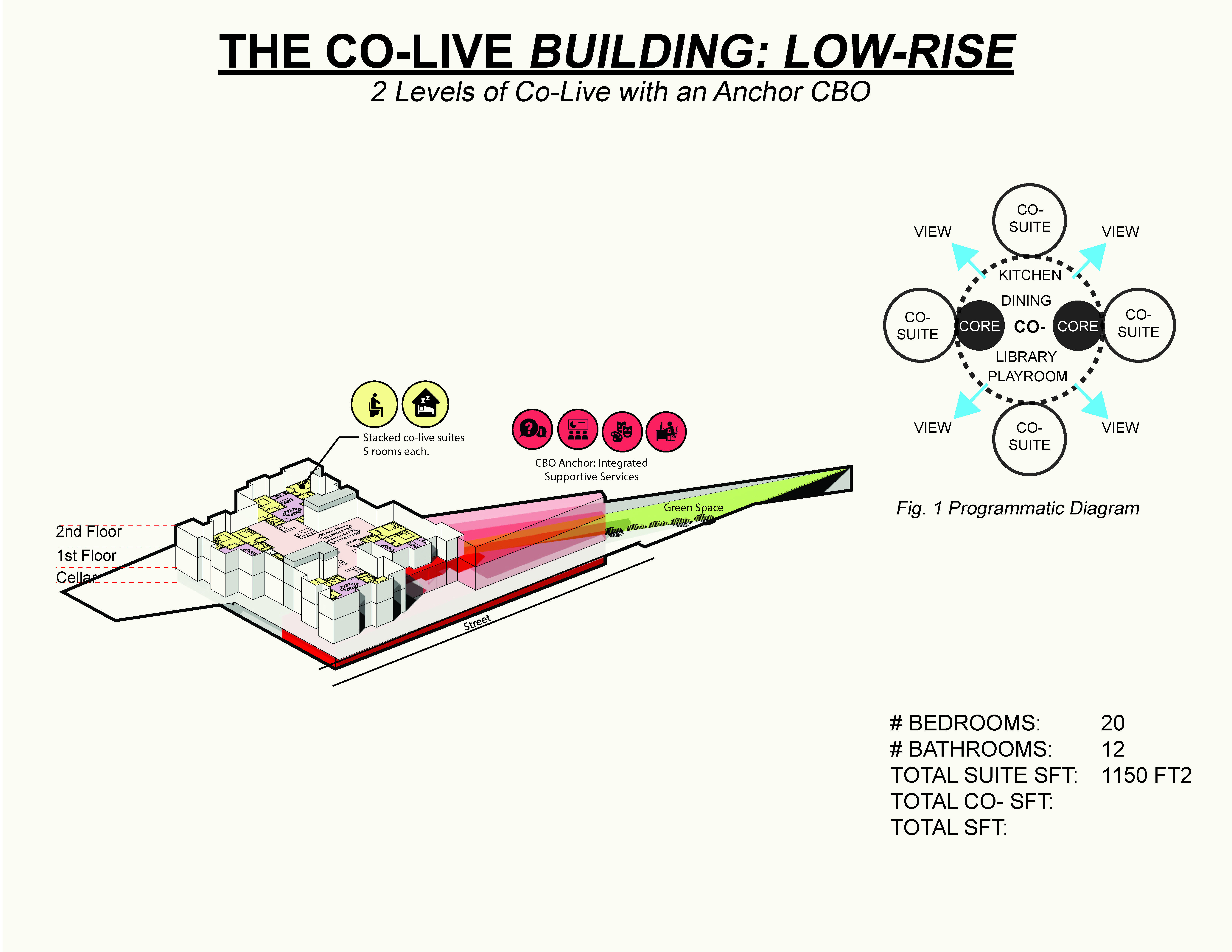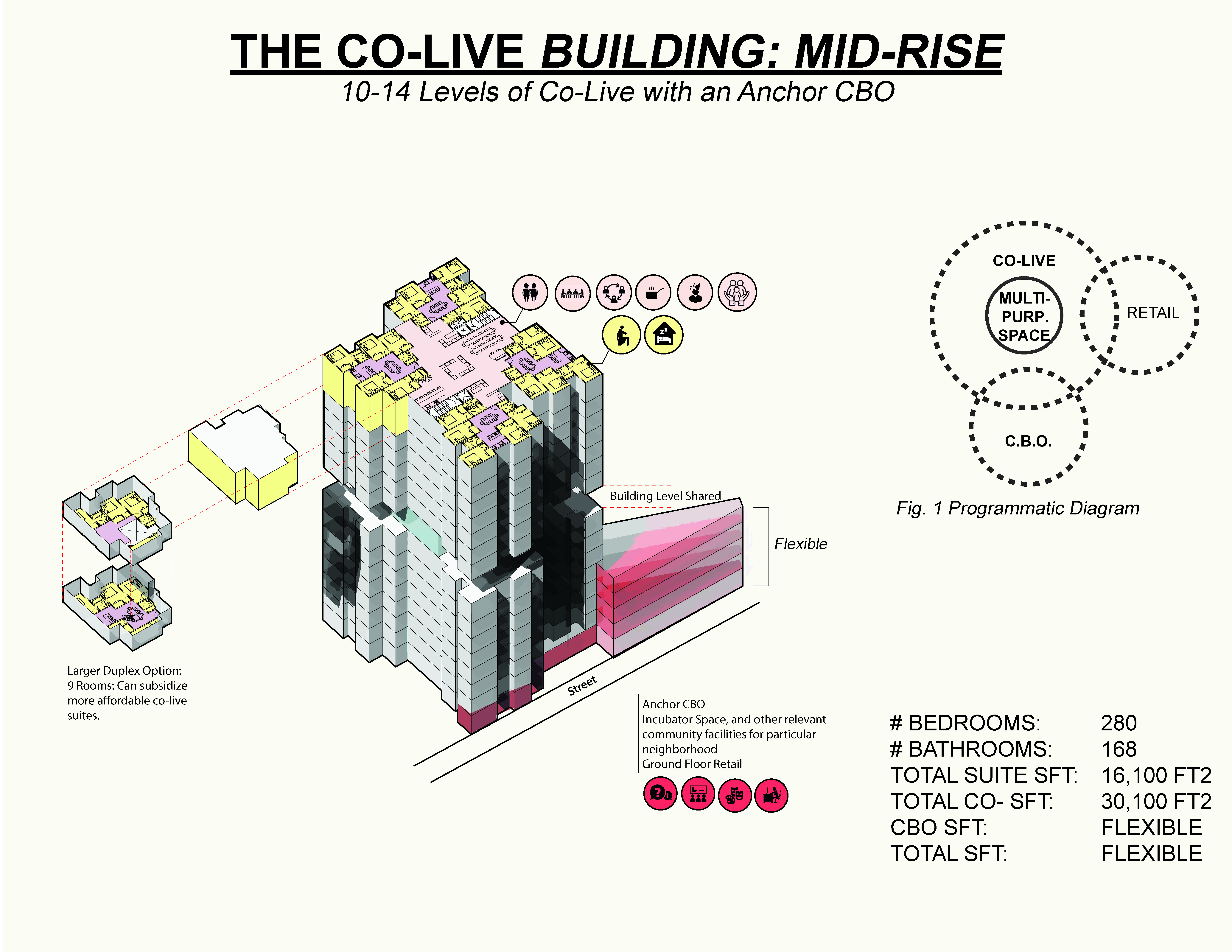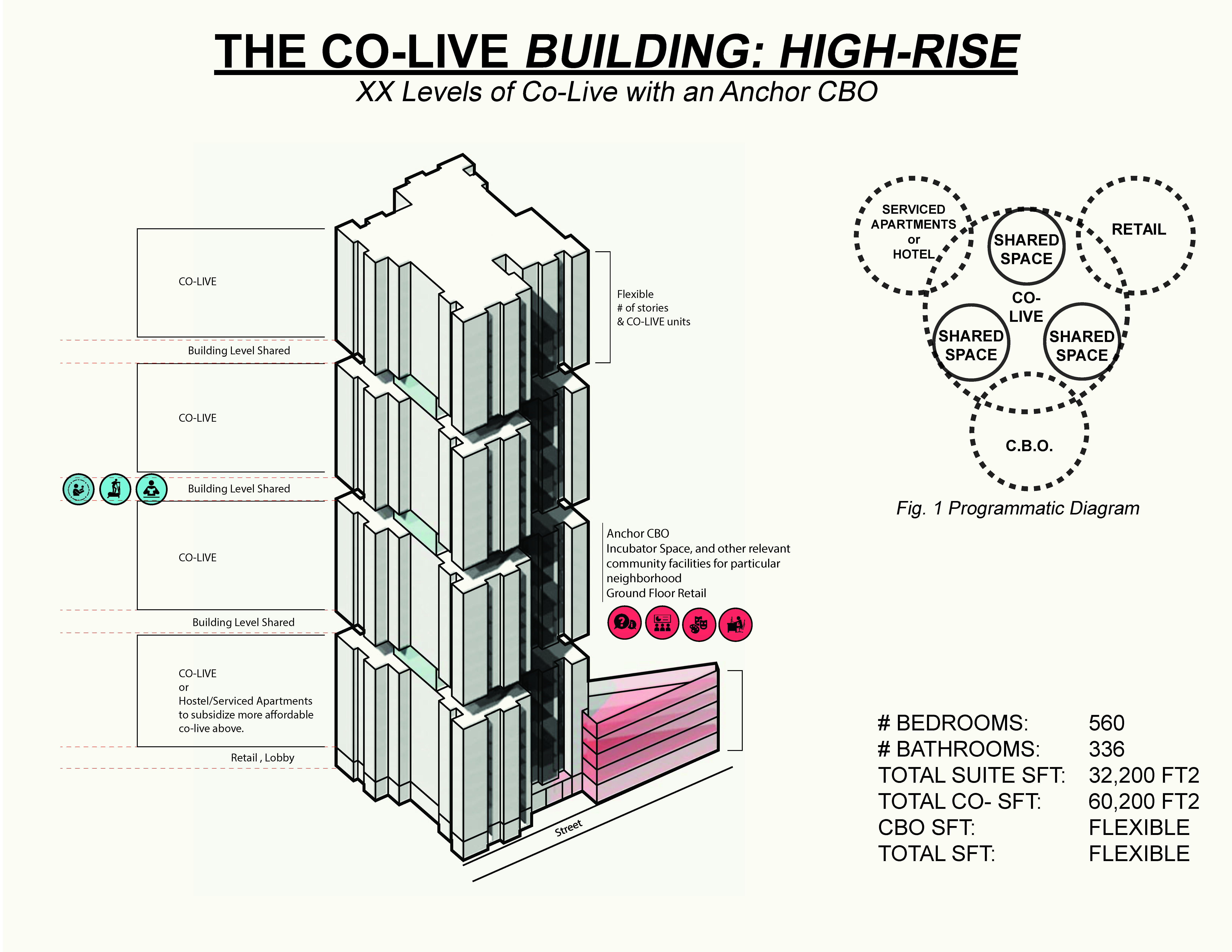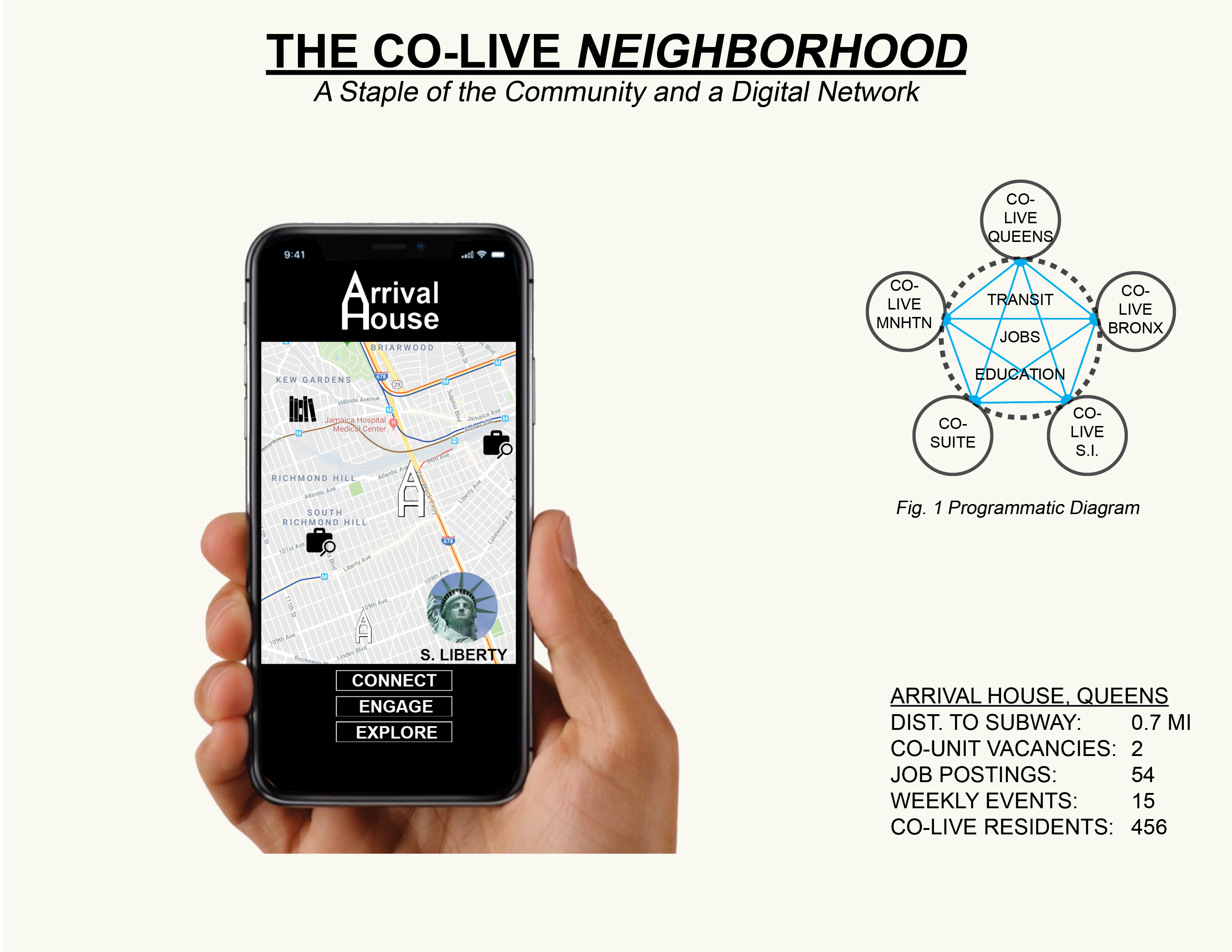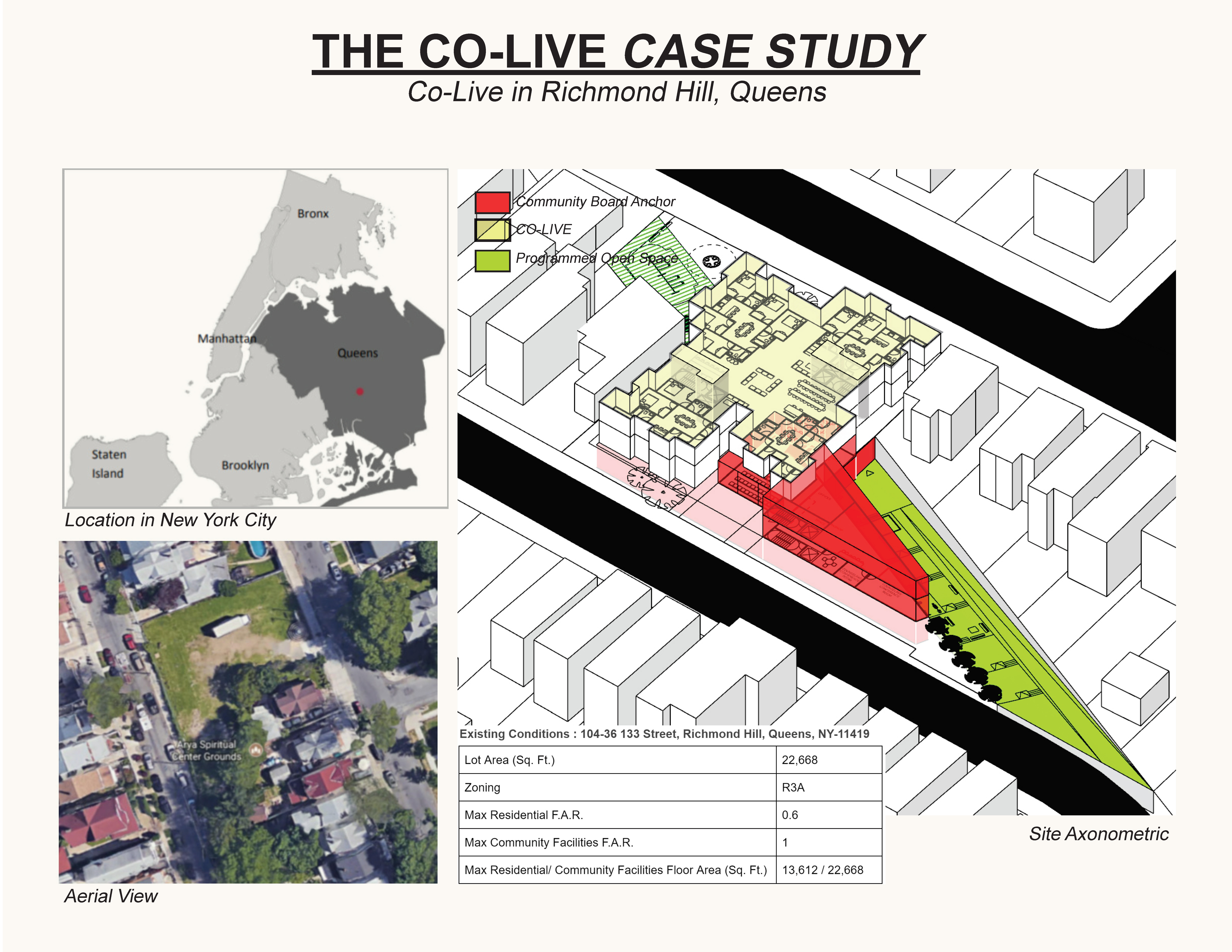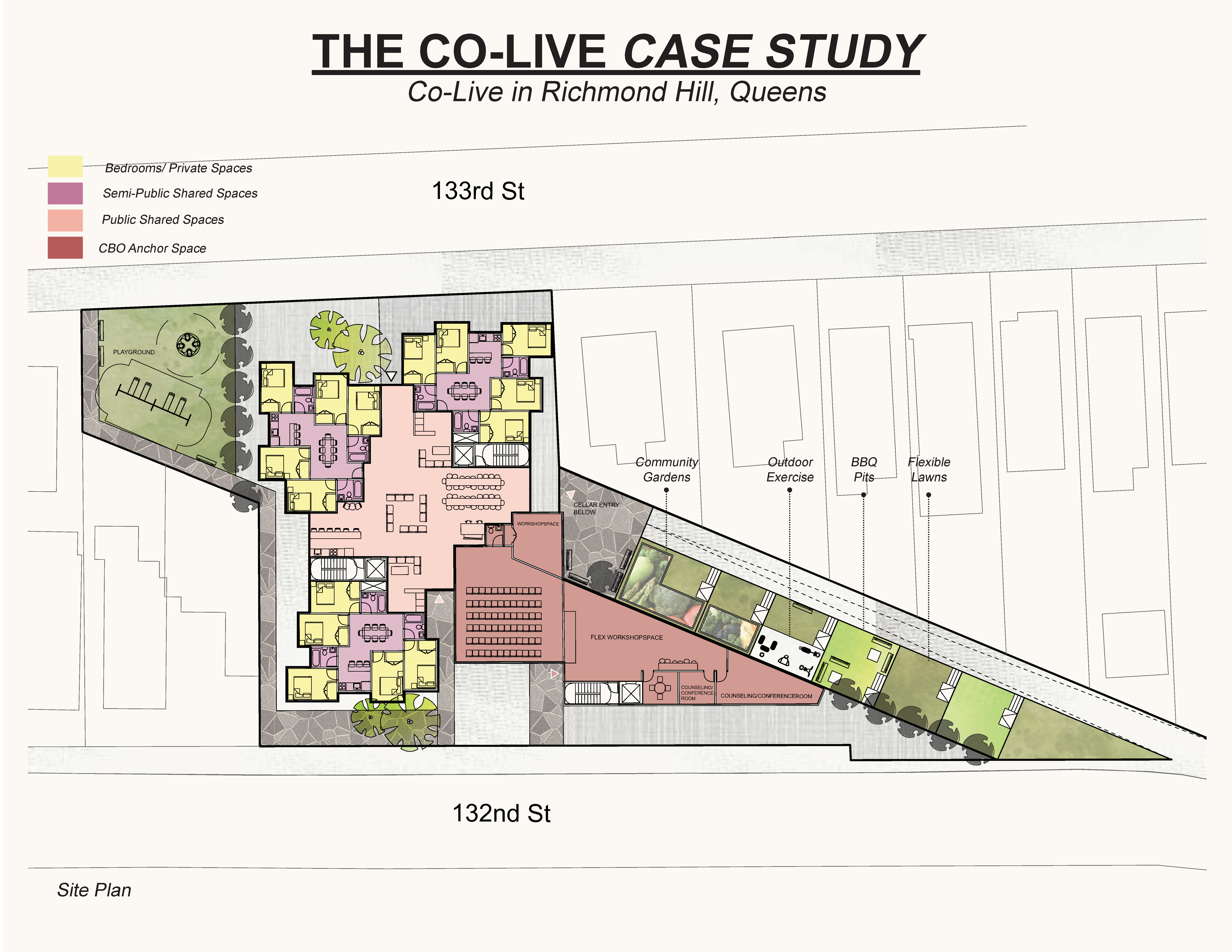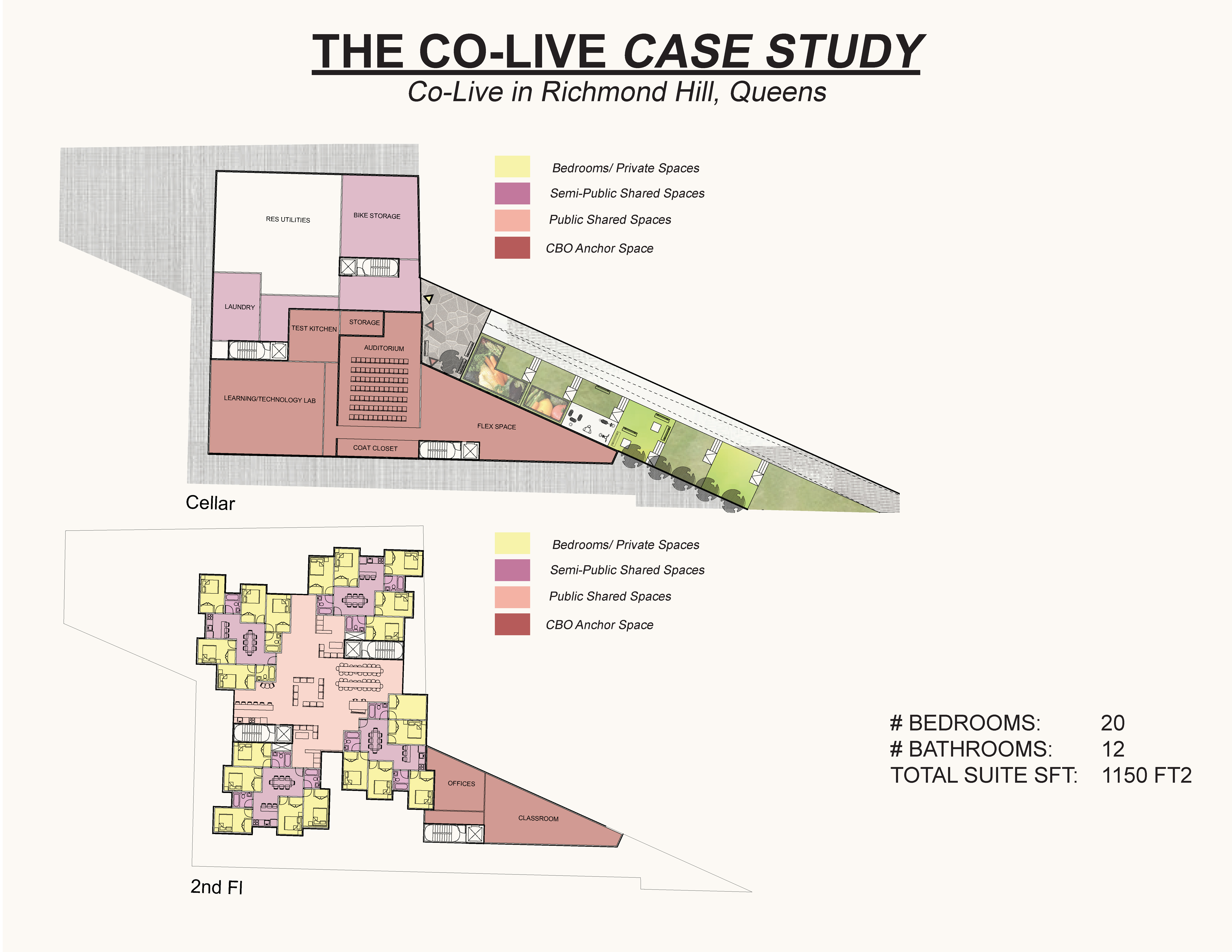How can we redesign and rethink housing to better integrate the arrival of immigrants to their new city?
A Co-Live Scenario for Newly Arrived Immigrants to New York City
A Co-Live Scenario for Newly Arrived Immigrants to New York City
New York City thrives on immigrants. Yet, complex issues make settling difficult for new arrivals. This project proposes a co-live scenario with integrated supportive services for the early transition of new arrivals to New York City. It empowers new immigrants to achieve a sustained, enriched, and quality living experience. We first summarize a general picture of new arrivals, including their experience, housing conditions, as well as challenges and opportunities. We then introduce the concept of co-living, regarding its historical precedents, current market, and potential opportunities for immigrant housing in NYC. Next, we prototype CO-LIVE as a new housing typology at the unit, building, and neighborhood scales with design principles and planning strategies. Finally, we validate this prototype by working collaboratively with a local housing advocacy organization for a proposed site in Richmond Hill, Queens.
NEW ARRIVAL EXPERIENCE
Finding affordable, stable, and quality housing is an essential part of arriving for new New Yorkers, and one of their greatest challenges. Since 2000, the immigrant population growth rate in NYC has surpassed citywide overall growth. Meanwhile, public housing, government assisted housing, or rent-stabilized housing has not been able to catch up to meet these needs. Lack of accessible housing options have forced newly arrived immigrants to seek alternative options. Typically, immigrants need to settle a larger household size (3.1 persons). This often places families in overcrowded living conditions (three times more dense than that of native-born New Yorkers). In addition to facing physical housing challenges, newly arrived New Yorkers also are confronted with policy barriers, regulation constraints, and market discrimination due to socio-economic disadvantages and limited resources. As a result, many undocumented immigrants live in illegally converted units, basement units, or overcrowded rentals. One estimate puts the number of such units at more than 100,000 citywide, concentrated in neighborhoods with high proportions of immigrants.
As immigrants settle in New York, they look to their families and immediate networks for help, and if aware, approach local Community Based Organizations (CBOs) for resources. In new housing developments that target the this newly arrived population, we consider it vital to integrate such social resources. In such spaces, residents can easily gain access to language help, technical education, job training, social connections, information assistance, legal aid, and other opportunities to settle and grow. Creating a more integrated housing structure to help immigrants succeed and prosper requires re-thinking typical housing models at the unit, building, and neighborhood scales.
The new arrival experience often involves group living in a shared space, a.k.a., co-living. Architecturally, many immigrants have larger families living together with multiple generations under one roof. Socially, they share and bond over cultural and domestic collaborative activities: preparing large meals together, eating together, collaborative childcare, and entertainment are far more communal in nature than that of nuclear households. In many cases, these co-living experiences connect individuals together forging a resilient community.
A CO-LIVING MODEL
Co-living is not new but rooted in NYC history in the forms of boarding houses, flop houses, single room occupancy (SROs), and extended-stay hotels. These co-living environments defined themselves by shared services and cheaper rent, with some offering meals and housekeeping, targeting demographics ranging from single women, transient seasonal workers, to families. During the 19th and 20th century, these housing arrangements doubled as social networks for new arrivals, thus shaping urban life. The downfall of these stays was due to their unhygienic living conditions, safety hazards defined by new regulations, and a rising real estate market that was unable to support lower-paying population.
While these co-living spaces and housing models are no longer available in NYC, immigrants typically settle informally in co-live situations. One bedroom in an apartment might contain four from a single family, with two other such families in the adjacent bedrooms, and even several single renters in the common areas. Cramped and unable to support a comfortable shared living space, such informal co-living is often illegal and undocumented. A formalized and regulated co-living housing model can beneficially address the immigrants’ needs as they settle in New York City. A new co-live housing model can improve the current informal condition by regulating design standards for co-living, creating sharing-friendly spaces with proper quality-of-life, and strengthening immigrants’ housing stability, making them less prone to exploitation from landlords.
Meanwhile, there has been a recent resurgence in the co-living housing market brought on by both the emerging sharing-economy and an increasing demand for quality housing. Companies such as Common, WeLive, and Campus have seized this opportunity by re-branding co-living as a cheaper option compared to market-rate rentals. These co-live housing rentals however are still not truly Affordable since they target international transitory professionals, entrepreneurs, and wealthy millennials. However, this trend triggered us to re-think co-living as a housing typology for newly arrived immigrants. We define CO-LIVE as a housing model that provides shared living spaces and integrated resources for newly arrived immigrants in NYC. In the form of a stabilized, community-based, shared living environment, CO-LIVE has the ability to positively address the housing challenges faced by immigrants upon their arrival, while effectively increasing housing unit supply and choices.
CO-LIVE DESIGN PRINCIPLES
We define CO-LIVE at the unit, building, and neighborhood scales. Design principles include proper dimensions of sharing, flexible use of space, and programming based upon local community’s needs. CO-LIVE provides a variety of spatial experiences by blurring spatial boundaries between ownership versus sharing, while connecting individuals with community.
A CO-LIVE unit is made of a collection of 4 CO-LIVE suites that share a large common area containing community spaces for cooking, eating, reading, and playing. The CO-LIVE suite contains 4-6 bedrooms with a small shared kitchen and dining area. In this way, the CO-LIVE unit provides a collection of private and shared spaces that offers both a space of retreat and personal connections. Residents share common spaces, such as the kitchen, living and dining areas, while also having their own private bedroom and dedicated bathrooms. The common area is the social hub of the CO-LIVE unit, where residents socialize, collaborate, and learn from one another. A range of suite types flexibly address the various needs of different immigrant populations, composed of 4-6 bedrooms, with no more than 2 people per room – able to serve individuals, couples, and families. The suite would come fully furnished and the utilities would be split between the suite residents.
CO-LIVE BUILDING
At the scale of the building, residents share and participate in supportive programming, easing their transition to NYC. The building will be the hub for access to services that support the residents’ arrival experience as they settle. Services include partnering with a local CBO, and providing multipurpose spaces that can be used flexibly for workforce development, daycare, and language lessons. Laundry, mailroom, and outdoor areas help support a healthy lifestyle. The community programming fosters a supportive and empowering environment for the new arrival community. Each CO-LIVE site will have an associated CBO that residents will have access to for resources needed during their early transition. It can be strategically located at the intersection, or within a certain radius of transit and high-immigrant density. Partnerships with anchor CBO’s will help identify key sites for purchase given their knowledge of the neighborhood, and resident needs.
At the building scale, low-rise, mid-rise, and high-rise building typologies can offer their own unique experience of CO-LIVE, increasing the amount of shared spaces as the building grows. For instance, at the high-scale scale, a CO-LIVE building will dedicate whole floors to amenities and multi-purpose spaces.There is also opportunity to cross subsidize affordable CO-LIVE units with serviced apartments, and market rate co-live at a larger scale.
CO-LIVE NEIGHBORHOOD
At the scale of the neighborhood, each CO-LIVE site will have an associated CBO that residents will have access to for resources needed during their early transition. It can be strategically located at the intersection, or within a certain radius of transit and high-immigrant density. Partnerships with anchor CBO’s will help identify key sites for purchase given their knowledge of the neighborhood, and resident needs. Beyond their immediate community, they will have access to a virtual portal that connects all CO-LIVE residents citywide. This virtual network will increase awareness of resources, events, as well as provide a broader support network for residents.
CO-LIVE CASE STUDY
CHHAYA + RICHMOND HILL, QUEENS PROPOSAL
To demonstrate CO-LIVE as a case study, we partnered with Chhaya Community Development Corporation (Chhaya for short) – a community based organization in Jackson Heights, Queens. Chhaya provides services to the South Asian community in Queens including “free direct services, education and outreach, community organizing, and research and policy, as well as both local and citywide coalition-building.” Focusing on the core areas of housing and economic development, their mission aligns with the concept of CO-LIVE as it advocates for housing stability, socioeconomic equity, and community sustainability.
Chhaya is expanding programs to better serve continuously growing local populations. They are planning on opening a satellite office in Richmond Hill, Queens, addressing the services needed for a high concentration of underserved South Asian and Indo-Caribbean communities. Eventually, their goal is to develop a site in the neighborhood for settlement housing, and a multipurpose community center. The challenges of the community include a lack of affordable and safe housing, and inadequate access to public benefits. Thus, we apply CO-LIVE as a potential solution for this neighborhood, providing an alternative housing model integrated with community-led programs and services.
PROJECT CONTEXT
Chhaya seeks to develop an 11,000 square foot mixed-use community center in Richmond Hill, Queens. The community center will provide social services and educational programs to 2,000 to 5,000 people annually, especially serving the diverse immigrant communities throughout the Richmond Hill-Ozone Park-Woodhaven areas. In addition to providing a space for Chhaya, this center will act as a conduit bringing other non-profit providers to the neighborhood with additional services and expertise. The overarching goal is to provide safe, accessible, multigenerational space, as well as comprehensive services celebrating diverse cultures for South Asian and Indo-Caribbean residents in South Queens.
Richmond Hill is a neighborhood located in Queens Community Board 9 that has over 153,200 people (2011-2015 ACS estimates) — over 50 percent of whom are foreign-born. 26% of district residents are Asian American, having increased from 12% due to growth in immigration. South Asians form the majority, including Indians, Pakistanis, and Bangladeshis, as well as people of Indo-Caribbean descent. The site is located between 132nd and 133rd street, currently owned by the Area Samaj Spiritual Center. Seeking a mutually beneficial partnership, the owner has offered to sell two plots to Chhaya as site for community center and housing development. Currently zoned as R3A, the site is vacant with no permanent structures and surrounded by single to double story family homes.
Currently, there are no South Asian community centers in the 10 to 15-mile radius from the site to build social capital for the community members. In working with William Spizak, the Program Director of Chhaya, we have identified the top five needs for programming: 1) Support in navigating social services in healthcare, legal aid, and immigration assistance; 2) Art and cultural activities such as music, crafts, and dance; 3) Career development such as job prep and search; 4) Special programs and services for youth and senior population; 5) Education including computer training, language classes, and counseling in health, child-care, and wellness. Chhaya desires to build at least 30 housing units and a community center with multiple workshop spaces, four counseling offices, a conference room, a learning & technology lab, a multi-purpose auditorium, and a community garden.
CONCLUSION
Housing is the cornerstone of settlement in that it defines economic activities, social connections, and most essentially, a home. Housing challenges for immigrants during early transition requires rethinking co-living for new arrivals. As a preliminary exploration, CO-LIVE defines design principles at the unit, building, and neighborhood scale to create a collaborative housing environment integrated with community services. Admittedly, there are barriers from current zoning ordinance and building regulation. Thus, we consider CO-LIVE can be further validated and achieved through combined efforts from bottom-up neighborhood CBO participation and top-down policy support.
As a sanctuary city, NYC is facing challenges of increasing population, scarcity of space, and socioeconomic inequity. Meanwhile as a creative city, it continuously embraces emerging opportunities of shared economy, innovative policy, and civic technology. These challenges and opportunities urge architects, planners, designers, and policy-makers to make CO-LIVE possible by defining principles, creating guidelines, breaking down the policy barrier, and engaging with the immigrant communities.



